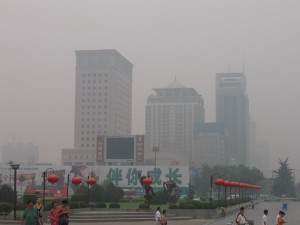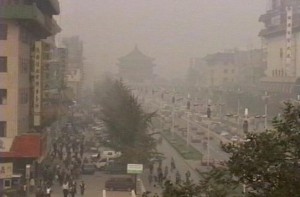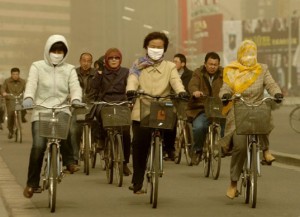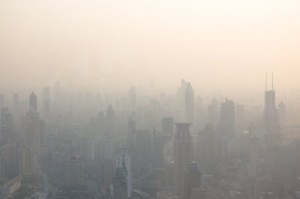A study came out of the city of Xian, China showing that people who were followed over 17 years that were exposed to smoke had a higher incidence of heart disease and stroke than those who didn’t. The numbers in this study were quite small, especially when compared with other larger studies. This study followed 910 people, as opposed to the 35,000 followed in a California study that showed no link to second hand smoke and disease.

From our hotel room looking into the city of Xian
But what is not stated is what is obvious to any who have lived or worked in China, especially the city of Xian. The pollution in Xian is far worse than any city in the United States in recent memory. Any westerner who goes to Xian will wake up with a cough, that will continue until they leave China. The particulate matter in such pollution has a well known, and well correlated rate of heart disease. In fact, the city of Xian has the worst air pollution in China, and often the second or worst in all of Asia.
Air pollution is a mix of gases, liquids, and particulate matter – at far higher concentrations than second hand smoke. There are very good studies that have shown increased risk for cardiac disease, stroke, and lung disease based on exposure to the material.
In China, especially in the growing cities, the pollution is based from coal- with high particulate matter, carcinogenic carbons which lead to increased clotting of blood vessels, increased systemic inflammatory responses, constriction of arteries, and a response that is far worse than noted with second hand smoke. The American Heart Association has clear scientific statements regarding air pollution, without ambiguity.
Particulate matter has been shown to have a relationship with heart rate. Even short term exposure to particulate matter (less than 2.5 um) increases the risk of hospital admission for cardiovascular and respiratory disease. These studies were done in the United States – where particulate matter is far less than in the city of Xian.
This May’s issue of JAMA showed that changes in air pollution levels during the Beijing Olympics were associated with acute changes in biomarkers of inflammation and thrombosis and measures of cardiovascular physiology in healthy young people.
JAMA in May of this year had an editorial “China’s Air Quality Dilemma: Reconciling Economic Growth with Environmental Protection” – May 16, 2012. Vol 307, No. 19.
What it points out is the air quality in Beijing, China, before and after the Olympics. The simple finding is even the USA’s most polluted city has less particles (2.5 um) than Beijing did during the Olympics. Most cities in the United States have, at their worse have 40 parts per million where during the Olympics Beijing had 70, and 85 after the Olympics.

Another view of Xian- on a good day
To be clear: I am a fan of China, and what they are doing with their air quality. It is clearly improving yearly. Compared to what the US had during the height of our industrial age, China is not only cleaner, but they are working hard to keep it clean. China is the large green giant, planting over 1 billion trees a year, and transforming an economy that was coal based to natural gas and atomic energy. But still its air pollution was described best: I had to smoke a cigar to get clean air while in China (anon).
So when a paper comes out, as in this last edition of Chest, and talks about Second hand smoke exposure in the city of Xian (which has far worse pollution than their capital and has the 2nd worst polluted air in the world),

From the City of Xian – where people routinely wear masks, they think second-hand smoke is the problem
and do not account for the particulate level in the air – this is at best a bad paper. What that paper did is equivalent to saying that eating tomatoes is bad because all those who ate tomatoes had heart disease and not account that they all were people with hyperlipidemia.
Even those who look at the data, without the perspective of being from China, cannot state that it is proof of second-hand smoke. Their Relative Risk factors are from 1 to 2.88 (recall the relative risk proving that cigarettes and cardiovascular disease are greater than 20, and that a relative risk of 3 is generally what we want for some indication of causation).
This was another bad study- quoted by Reuters, picked up by the AMA daily News.
China has been recently upset that America has been tweeting about the air quality in China. From Yahoo News:
The United States said Wednesday that its embassies in China would not stop tweeting reports on air quality readings in Beijing and Shanghai, which have annoyed the Chinese authorities. “This is an initiative by the embassy in Beijing, by the mission in China, to convey what we believe is useful information to our citizens abroad,” State Department spokesman Mark Toner told journalists. “It’s primarily directed to American citizens, but in terms of Chinese accessing this information, we don’t have a problem with it.
“We would see it as a model for other missions around the globe to do,” Toner said, adding in the past there had been a similar initiative in Mexico.
He added that despite Beijing’s assertions that it was illegal for foreign embassies to issue their own air quality readings the US embassy had no plans to stop sending out the reports on its dedicated Twitter feed.
China’s cities are among the world’s most polluted, but until recently, official air quality measurements regularly rated their air quality as good — even as data from the US embassy in Beijing showed off-the-chart pollution.
Toner said the Beijing embassy now had some 20,000 followers of its Twitter feed which goes by @BeijingAir, and which said early Thursday that the air quality was “unhealthy for sensitive groups” in the Chinese capital.

Recent photo of Shanghi at Sunset
Bottom line- second hand smoke remains the myth that tries so hard to be proven.
REFERENCES:
For the most comprehensive article on second hand smoke here.
Secondhand smoke exposure predicted chronic obstructive pulmonary disease and other tobacco related mortality in a 17-years cohort study in China. He, Y., et. al. Chest. 2012 printed online
http://chestjournal.chestpubs.org/content/early/2012/05/22/chest.11-2884.abstract
China’s Air Quality Dilemma: Reconciling Economic Growth with Environmental Protection. Dominici, F, Mittleman, MA. JAMA 2012, 307(19) 2100-2102
Brook RD, Rajagopalan S, Pope CA III, et al; American Heart Association Council on Epidemiology and Prevention, Council on the Kidney in Cardiovascular Disease, and Council on Nutrition, Physical Activity and Metabolism. Particulate matter air pollution and cardiovascular disease: An update to the scientific statement from the American Heart Association. Circulation. 2010;121(21):2331-2378
Rich DQ, Kipen HM, Huang W, et al. Association between changes in air pollution levels during the Beijing Olympics and biomarkers of inflammation and thrombosis in healthy young adults. JAMA. 2012;307(19):jpc1200022068-2078
